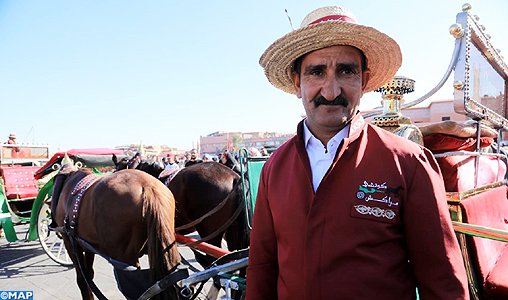
This makeover operation, which was officially launched on Monday, on the occasion of the 64th anniversary of Independence Day, aims to improve the brand image of the ochre city.
The dress would not make a monk, but the fact remains that with this uniform, the service offered by the carriages increases in rank and is a little more similar to a service as professional as it is prestigious.
On the side of tourism professionals and the 148 horse-drawn carriage drivers in the ochre city, we welcome this initiative, which contributes to the enhancement of this profession, which gives pride of place to ecological transport.
But this uniform is not the only evolution that will be beneficial to this sector. Indeed, from now on, all Marrakech horse-drawn carriages will be subject to a daily control: confidence permit for drivers, condition of vehicles and horses and electronic chips and serial numbers for horses in carriages.
Other advances include the horse carriage protection program, farrier training, the Imlil Mule Assistance Program (AMI) and the zootherapy program for people with special needs.
The horse carriage protection program initiated by the Society for the Protection of Animals and Nature (SPANA) and the Royal Horse Encouragement Society (SOREC), includes 3 mandatory technical inspections (health inspection for horses and technical inspection for carriages), regular inspections during which SPANA provides free care and treatment and identifies new horses, identifies them by electronic chips and a numbered strip and organizes an annual competition and awards prizes to owners who take the best care of their horses and carriages.
Launched in 1999, the AMI program offers free services to mules and muleteers in the douars of Imlil, Armed, M’Ziq and Ait Souka, including two annual veterinary and technical inspection visits, a monthly visit, emergency response, the distribution of protective bits, shackles, collars and bandages and the organization of an annual competition to award the owners who best maintain their mules.
The farrier training program aims to train about 20 farriers per year, organize continuing training for veterinarians in orthopedic farriers and raise the professional level and social status of farriers.
The presentation of this battery of innovations was made on Monday in the presence of the wali of the Marrakech-Safi region, governor of the prefecture of Marrakech, Karim Kassi-Lahlou, the president of the Marrakech Municipal Council, Mohamed Larbi Belkaid and local elected officials.


Be the first to comment